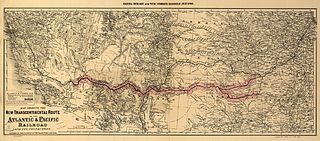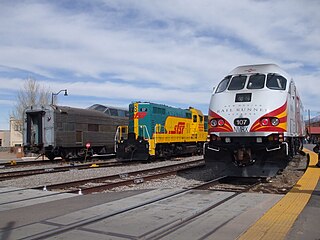Related Research Articles

New Mexico is a state in the Southwestern United States. It is one of the Mountain States of the southern Rocky Mountains, sharing the Four Corners region of the western U.S. with Utah, Colorado, and Arizona, and bordering Texas to the east and southeast, Oklahoma to the northeast, and the Mexican states of Chihuahua and Sonora to the south. The state capital is Santa Fe, which is the oldest capital in the U.S., founded in 1610 as the government seat of Nuevo México in New Spain; the largest city is Albuquerque (1706).

Albuquerque, abbreviated ABQ, is the most populous city in the U.S. state of New Mexico. Its nicknames, The Duke City and Burque, both reference its founding in 1706 as La Villa de Alburquerque by Nuevo México governor Francisco Cuervo y Valdés. Named in honor of the Viceroy of New Spain, the 10th Duke of Alburquerque, the city was an outpost on El Camino Real linking Mexico City to the northernmost territories of New Spain.

BNSF Railway is one of the largest freight railroads in North America. One of seven North American Class I railroads, BNSF has 35,000 employees, 32,500 miles (52,300 km) of track in 28 states, and nearly 8,000 locomotives. It has three transcontinental routes that provide rail connections between the western and eastern United States. BNSF trains traveled over 169 million miles in 2010, more than any other North American railroad.

The Atchison, Topeka and Santa Fe Railway, often referred to as the Santa Fe or AT&SF, was one of the larger railroads in the United States. The railroad was chartered in February 1859 to serve the cities of Atchison and Topeka, Kansas, and Santa Fe, New Mexico. The railroad reached the Kansas–Colorado border in 1873 and Pueblo, Colorado, in 1876. To create a demand for its services, the railroad set up real estate offices and sold farmland from the land grants that it was awarded by Congress.

The New Mexico Rail Runner Express is a commuter rail system serving the metropolitan areas of Albuquerque and Santa Fe, New Mexico. It is administered by the New Mexico Department of Transportation (NMDOT) and the Rio Metro Regional Transit District, a regional transportation agency, while Herzog Transit Services currently holds the contract for the operation and maintenance of the line & equipment. Phase I of the system, operating on an existing right-of-way from Belen to Bernalillo that NMDOT purchased from BNSF Railway, opened in July 2006. Phase II, the extension of the line to Santa Fe, opened in December 2008. Daily ridership, as of February 2019, was 2,200 trips per day. In 2021, the system had a ridership of 256,500, or about 1,800 per weekday as of the second quarter of 2022.

Santa Fe 2926 is a former Atchison, Topeka and Santa Fe Railway (ATSF) class 2900 4-8-4 type steam locomotive, built by Baldwin in 1944. It was used to pull passenger and fast freight trains, mostly throughout New Mexico, until its fire was dropped on Christmas Eve of 1953, and it was retired from revenue service. It was subsequently donated to a park in Albuquerque for static display. In 1999, it was purchased by the New Mexico Steam Locomotive and Railroad Historical Society to be rebuilt for operational purposes. After over twenty years of work, No. 2926 steamed up again on July 24, 2021, and will eventually be used in mainline excursion service between Albuquerque and Las Vegas, New Mexico.

The Atlantic and Pacific Railroad was a U.S. railroad that owned or operated two disjointed segments, one connecting St. Louis, Missouri with Tulsa, Oklahoma, and the other connecting Albuquerque, New Mexico with Needles in Southern California. It was incorporated by the U.S. Congress in 1866 as a transcontinental railroad connecting Springfield, Missouri and Van Buren, Arkansas with California. The central portion was never constructed, and the two halves later became parts of the St. Louis-San Francisco Railway and Atchison, Topeka and Santa Fe Railway systems, now both merged into the BNSF Railway.

The Santa Fe, Prescott and Phoenix Railway (SFP&P) was a common carrier railroad that later became an operating subsidiary of the Atchison, Topeka and Santa Fe Railway in Arizona. At Ash Fork, Arizona, the SFP&P connected with Santa Fe's operating subsidiary, the Atlantic & Pacific Railroad mainline, that ran from California to Chicago. The SFP&P's 195-mile (314 km) line extended the Santa Fe Railway south into Phoenix. The SFP&P extended another 100 miles (160 km) to the east from Phoenix to Florence and Winkelman via the Phoenix and Eastern Railroad. The SFP&P also served several mines in the Prescott area, including the Derby Mine by way of the Summit (flag) Station at 'Prieta' in the Sierra Prieta range, through its various subsidiary railroads.

The historic U.S. Route 66 ran east–west across the central part of the state of New Mexico, along the path now taken by Interstate 40 (I-40). However, until 1937, it took a longer route via Los Lunas, Albuquerque, and Santa Fe, now roughly New Mexico State Road 6 (NM 6), I-25, and US 84. Large portions of the old road parallel to I-40 have been designated NM 117, NM 118, NM 122, NM 124, NM 333, three separate loops of I-40 Business, and state-maintained frontage roads.

Santa Fe Depot in San Diego, California, is a union station built by the Atchison, Topeka and Santa Fe Railway to replace the small Victorian-style structure erected in 1887 for the California Southern Railroad Company. The Spanish Colonial Revival style station is listed on the National Register of Historic Places and is a San Diego Historic Landmark. Its architecture, particularly the signature twin domes, is often echoed in the design of modern buildings in Downtown San Diego.

The Panhandle and Santa Fe Railway (P&SF) is a now-defunct railroad company that was a subsidiary of the Atchison, Topeka and Santa Fe Railway (AT&SF), operating primarily in the Texas Panhandle.

Tijeras Canyon is a prominent canyon in the central part of the U.S. state of New Mexico. It separates the Sandia Mountains subrange to the north from the Manzano Mountains subrange to the south. These subranges are part of the larger Sandia–Manzano Mountains; Tijeras Canyon forms a pass through this range. Elevations along the bottom of the canyon range from 5,600 feet (1,700 m) to 7,000 feet (2,100 m) above sea level. The canyon drains to the west, into a large dry wash known as Tijeras Arroyo, which runs through Kirtland Air Force Base, passes just south of the Albuquerque International Airport, and then joins the Rio Grande. The arroyo heads at the historically important pass, and this pass and the entire canyon are traversed by Interstate 40, following the path of historic U.S. Route 66.

Interstate 40 (I-40), a major east–west route of the Interstate Highway System, runs east–west through Albuquerque in the US state of New Mexico. It is the direct replacement for the historic U.S. Highway 66 (US 66).

The Santa Fe Southern Railway is a short line railroad in New Mexico, United States. In addition to carrying freight on occasion, it also operates as a tourist railroad called Sky Railway that carries passengers between Lamy and Santa Fe: a distance of 18.1 miles (29.1 km). The Santa Fe Rail Trail, a multi-use trail, parallels its route.

The Southern Transcon is a main line of BNSF Railway comprising 11 subdivisions between Southern California and Chicago, Illinois. Completed in its current alignment in 1908 by the Atchison, Topeka and Santa Fe Railway, when it opened the Belen Cutoff in New Mexico and bypassed the steep grades of Raton Pass, it now serves as a mostly double-tracked intermodal corridor.
The Chili Line, officially known as the Santa Fe Branch, was a 3 ft narrow-gauge branch of the Denver and Rio Grande Western Railroad (D&RGW). It ran 125.6 miles (202.1 km) from Antonito, Colorado, to Santa Fe, New Mexico. The Denver and Rio Grande Railway (D&RG) began construction of the line in 1880 and completed the line from Antonito to Española, New Mexico, but could not build any further because of an agreement with the Atchison, Topeka and Santa Fe Railroad (AT&SF). The Texas, Santa Fe and Northern Railroad was incorporated to complete the line, and the line between Española and Santa Fe opened in 1886 and was transferred to the Denver and Rio Grande shortly thereafter. The D&RGW closed the Chili Line in 1941 because of competition from road transportation, and the line was abandoned shortly thereafter.

Isleta Station was a railway station on the Atchison, Topeka and Santa Fe Railway in Isleta, New Mexico. Located twelve miles south of Albuquerque, Isleta was a junction station, located at the point where two lines split. One line went to El Paso, Texas while the other was the main line to Los Angeles. The Southwest Chief passenger train now passes by on the L.A. line.

Tolar, New Mexico is a ghost town in the panhandle of northern Roosevelt County that existed in the 20th Century. The site is at the intersection of New Mexico State Road 86 and U.S. Routes 60 and 84 between Fort Sumner in De Baca County and Melrose in Curry County. Tolar was established as a stop on the Belen Cutoff of the Santa Fe Railway in 1907. A train carrying munitions exploded there in 1944, causing the largest accidental explosion in New Mexico history.
The New Mexico Central Railroad was formed in 1908 from the consolidation of the Santa Fe Central Railway and the Albuquerque Eastern Railway Co., to operate the 116 miles of track between Torrance and Santa Fe, New Mexico. That line, reorganized in 1918 as the New Mexico Central Railway, was sold to the Atchison, Topeka and Santa Fe Railroad in 1926. The New Mexico Central remained the nominal owner of the Santa Fe-leased line while the Santa Fe proceeded to abandon operation of the trackage in pieces, ending in 1972 with abandonment from Willard to Calvert (Moriarty), New Mexico.
The Albuquerque Eastern Railway, sometimes called the Albuquerque Eastern Railroad, was chartered July 22, 1901, by the same parties interested in the Santa Fe Central Railway which was completed in 1903 between a rail junction at Torrance, New Mexico and Santa Fe, New Mexico. The plan was for the Albuquerque Eastern to branch from the Santa Fe Central at Moriarty, New Mexico and run 43 miles west through the Tijeras Pass to Albuquerque. The entire line was graded with a railbed, however, construction was halted in 1905 after only the first 8 miles of track out of Moriarty had been built, due to the Comptroller of the Currency closing the doors of the bank financing the construction.
References
- ↑ "History of New Mexico: Its Resources and People, Volume II". 1907. Retrieved September 25, 2021.
- 1 2 3 4 5 Myrick, David F. (1990). New Mexico's Railroads: A Historical Survey. ISBN 9780826311856 . Retrieved September 22, 2021.
- ↑ Governor, New Mexico (1903). "The Santa Fe Central Railway, Report of the Governor of New Mexico to the Secretary of the Interior, 1903" . Retrieved September 25, 2021.
- ↑ "Receivership of the New Mexico Central Railroad Co., Extension of Tenure of Government Control of Railroads, Volume 3". 1919. Retrieved September 25, 2021.